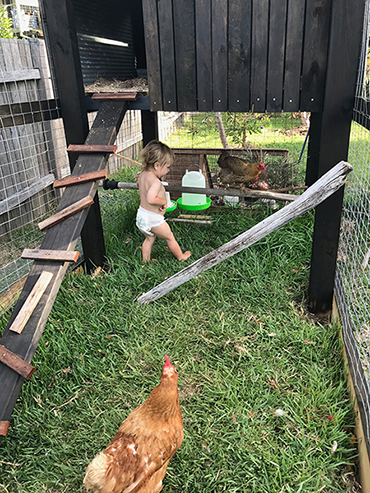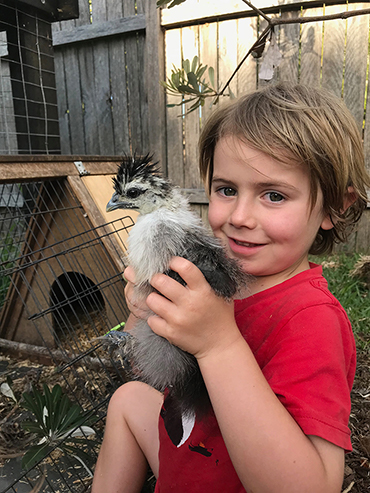National Chook Health Week case study:
‘Cuteness-factor’ more precious even than eggs
WHO: Lucy, James, Will and Sam
WHERE: Jervis Bay, NSW
To anyone running through the names of the Robertson-Morton family’s feathered friends, their owners’ affection for the flock is clear.
“There’s Blackie the Silkie Bantam rooster and the Bantam hens are Cheeky, Nicey, Cutie, Stripey, Medium, Oprah and Lady Gaga,” Lucy Robertson says. “They’re a mixture of Silkies, Barred Rock, Polish and Pekin.”

‘Blackie’ the cockerel loves his outdoor coop.
Although Lucy says she and husband James Morton are “relatively new chook owners”, both have long understood the benefits of poultry-keeping.
“Can you believe neither of us had chooks growing up? An outrage!” says Lucy, who was raised on an organic vineyard and winery at Mudgee in the NSW Central West.
Lucy and James and their two sons now live on the state’s South Coast, not far from James’ childhood home.
“We took our time building a coop and the girls arrived about 12 months ago.
“We’ve grown our own vegies and fruits and herbs for many years, as well as composted our food scraps, but the addition of chooks to eat the weeds and create manure for the garden and eggs for the kitchen seemed like a no-brainer from a permaculture/sustainability point of view.
“The real push came from our kids after they hatched hen eggs in an incubator at preschool and fell in love with them.”

Sam with hens in the coop.
Lucy, James and the boys welcomed their flock incrementally.
“Our first two came as laying hens,” Lucy says.
“A couple more were bought at point-of-lay, and our two Silkies were little fluffy pullets about eight weeks old.
“Four ‘divorce chooks’ came later after some friends separated and neither could keep the chickens.”
Lucy says the couple’s now-five-year-old son Will “has appointed himself ‘Boss of the Chickens’ and needs to be reminded on a daily basis that he can’t smuggle them into his bed, nor try to sleep in their nesting boxes”.
“The kids love them,” she says. “They help with feeding and collecting the eggs.”
As far as interaction with other household members goes, the chooks have adapted well to having Lucy and James’ 10-year-old Labradoodle, Mylo, nearby.

Will with ‘Cheeky’ the pullet.
Other furred creatures are kept well away, however.
“We took great care to fox-proof our coop as we do live in an area with foxes and have had neighbours and friends who’ve lost girls to these nasty things,” Lucy says.
“We built a timber and corrugated-iron coop with an integrated run in the backyard.
“We live on a bay fringed by mangroves, and king tides sometimes inundate the backyard so we needed their coop to be elevated off the ground in the event of flooding.
“They nest and roost in this box-like structure perched at one end of the coop and have a lot of outside area to free-range in safely during the day.
“We did have some isolated dramas with a grey goshawk once that killed a pullet when the girls were out in the backyard and then kept coming back to the coop for a few weeks looking for another opportunity.
“We strung up some hawk deterrents like tinsel and plastic flags and put a wire roof on the run just in case and haven’t had any problems since.
“They often come out into the garden when we’re at home for at least a couple of hours,” Lucy says.
At other times they simply stay inside the secure run, supplied with enough food and water to keep them perfectly satisfied for a few days.
“We’ve only had to organise people to look after them a couple of times: once for three or four days and once for almost two weeks,” she says.
“We’re lucky to have fantastic neighbours and friends who’ve covered for us.”

Sam cuddling a pullet.
Lucy and James feed their flock a multigrain blend known as ‘free-range scratch’ mixed with a pelleted premium layer feed.
“We add extra sunflower seeds and cracked corn because they love it and cluck happily whenever we pull it out, and we provide shellgrit separately.
“Plus, they get daily fruit and veg scraps, worms and grubs from the garden and sometimes mealworms for extra treats.
“We check them visually for lice and mites and check their feet every few weeks – just through regular handling.”
As a special pleasure the chooks are given baths in warmer weather which double as an opportunity for a thorough check-over.
In return, the eggs they contribute are appreciated greatly.
“Bantams don’t lay a huge number of eggs and they’re smaller than the commercial eggs we see in shops from larger breeds, but they’re delicious.
“We usually collect between two and four eggs per day.”
See more about National Chook Health Week here.

